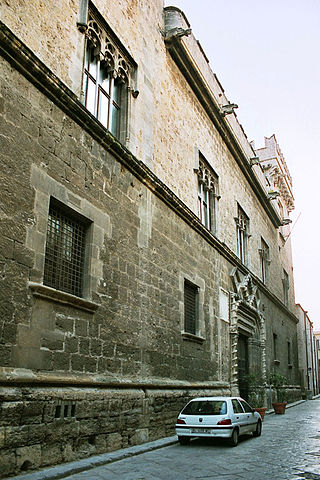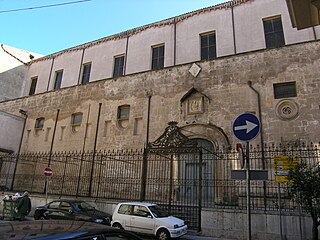
The Church of St. Mary of the Admiral, also called Martorana, is the seat of the Parish of San Nicolò dei Greci, overlooking the Piazza Bellini, next to the Norman church of San Cataldo and facing the Baroque church of Santa Caterina, in Palermo, Italy.

The Villa Spedalotto is the country home of the Paternò di Spedalotto family. The villa is situated on a hill surrounded by olive groves at Bagheria, near Palermo in Sicily. As all the Villas in Bagheria, it was built as a country house, and was traditionally used by the family only during the spring and autumn. While considered a national monument, it remains a private residence.

Palazzo Abatellis is a palazzo in Palermo, Sicily, southern Italy, located in the Kalsa quarter. It is home to the Galleria Regionale della Sicilia, the Gallery of Art for the Sicilian region.

The Church of the Gesù, known also as the Saint Mary of Jesus or the Casa Professa, is a Baroque-style, Roman Catholic church established under the patronage of the Jesuit order, and located at Piazza Casa Professa 21 in Palermo, region of Sicily, Italy.

Santa Maria della Gancia, also known as Santa Maria degli Angeli, is a 15th-century Roman Catholic church, adjacent to a convent, located on Via Alloro #27 in central Palermo, region of Sicily, Italy.

Gioacchino Martorana was a Sicilian painter. He was the son of Pietro Martorana and a member of an extended family of decorators and artists from Palermo.
Pietro Martorana (1705–1759) was a Sicilian painter. He was the father of Gioacchino Martorana and a member of an extended family of decorators and artists from Palermo.

The Church of Saint Ursula of the Blacks is a Baroque-style, Roman Catholic church located in the central Via Maqueda #110, adjacent to the Palazzo Comitini, in the quarter of the Albergaria, within the historic centre of Palermo, Region of Sicily, Italy.

The Chinese Palace, also known as Real Casina alla Cinese, is a former royal residence of the House of Bourbon-Two Sicilies designed in the style of Chinoiserie. It is located in Palermo, inside the park of La Favorita. The Ethnographic Museum of Sicily, named after Giuseppe Pitrè, is located in one of the Palace's guesthouse.

The Biondo Theatre is a neoclassical and Art Nouveau-style theater building located on Via Roma #258, corner with Via Venezia, in the ancient quarter of Castellamare of central Palermo, region of Sicily, Italy. Diagonally across Via Roma is the ancient church of Sant'Antonio Abate and a stairwell descending into the warrens of the Vucciria Market.

Palazzo Comitini, complete name Palazzo Gravina di Comitini, is a Baroque palace located on Via Maqueda #100, adjacent to the church of San'Orsola in the quarter of Albergheria, in the historic center of Palermo, region of Sicily, Italy. Presently, it is the official seat of the Metropolitan City of Palermo and the columns flanking the portal read Palazzo della Provincia.

Villa Malfitano Whitaker is a 19th-century villa in Via Dante, in the quarter of Politeama of Palermo, Sicily. It is presently a museum displaying Whitaker's natural history and archaeological collections, as well as his artwork.

The Palazzo Alliata di Villafranca is former aristocratic mansion, now converted into a museum, located just off Via Vittorio Emanuele facing the Piazza Bologni which opens two blocks west of the Quattro Canti intersection, in the ancient quarter of the Albergaria of the city of Palermo, region of Sicily, Italy.

The Oratorio di San Giuseppe dei Falegnami is a Baroque chapel or prayer room located across the Via Giuseppe d'Alessi from the church of San Giuseppe dei Teatini in the quarter of the Albergaria, within the historic centre of Palermo, region of Sicily, Italy.

The Palazzo Celestri di Santacroce, also known as the Palazzo Sant'Elia is a Baroque-style aristocratic palace located on via Maqueda 90 in the ancient quarter of Kalsa of central Palermo, region of Sicily, Italy. Once the urban palace of a wealthy and prominent family, a large portion of the palace is now used for exhibitions and private functions. The palace is diagonal to the Southeast of the Palazzo Comitini, and just a block north of the church of the Assunta.
The Palazzo Speciale Raffadeli is a Gothic-style aristocratic palace located on Via Giuseppe Mario Puglia #2, a block north of the church of Santa Chiara all'Albergaria in the ancient quarter of Albergaria, in central Palermo, region of Sicily, Italy.

The Palazzo Jung is a Neoclassical-style palace located on Via Lincoln, in front of the Orto Botanico of Palermo, in the city of Palermo, region of Sicily, Italy.

The Palazzo Butera is a Baroque-style aristocratic palace located facing the Mediterranean in the ancient quarter of Kalsa of central Palermo, region of Sicily, Italy. On the shoreside, the long facade has a wide terrace, built atop the base of the former walls and called Passeggiata delle Cattive, in front of this is the park Foro Italico, in front, rising just south of Porta Felice and Via Vittorio Emanuele ; the access to the palace is from the land-side street of Via Butera.

San Giovanni dell'Origlione is a Baroque-style,deconsecrated, Roman Catholic church located on Piazza Origlione, at the intersection of via Saladino and via Santissimo Salvatore in the ancient quarter of Albergaria of the city of Palermo, region of Sicily, Italy. It was once attached to a convent of cloistered Benedictine nuns, but after years of abandon, is presently undergoing restoration.

Madonna dei Rimedi is a Baroque-style, Roman Catholic Sanctuary-church, established and still affiliated with the Discalced Carmelite order, located on Piazza Indipendenza # 9, in Palermo, region of Sicily, Italy.



















